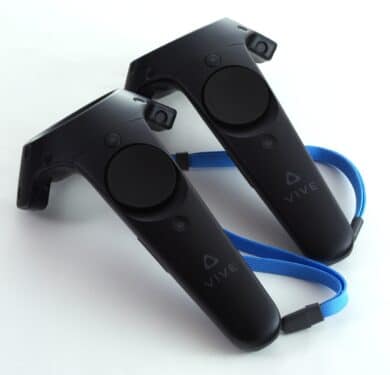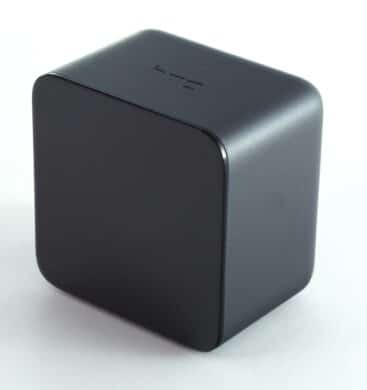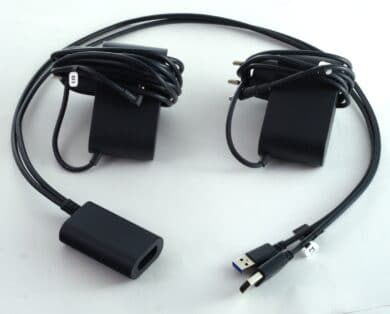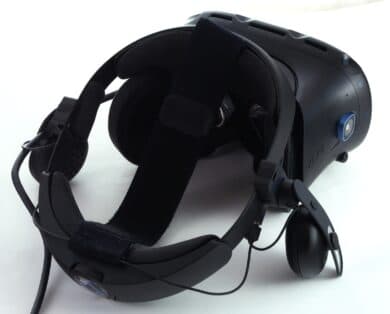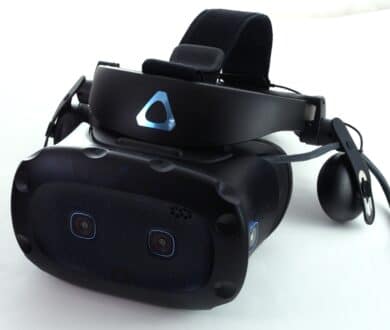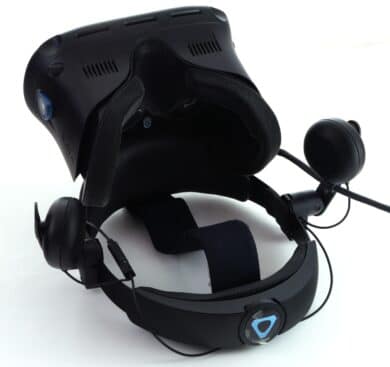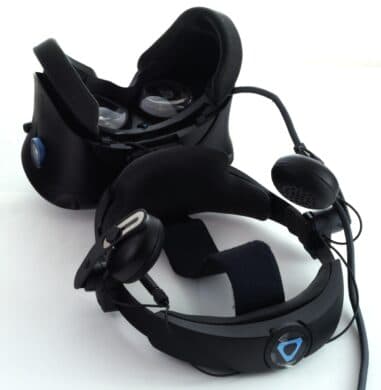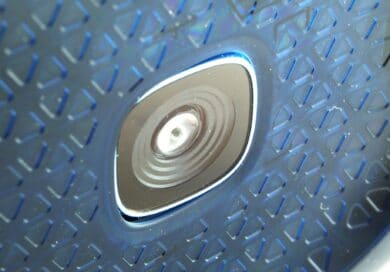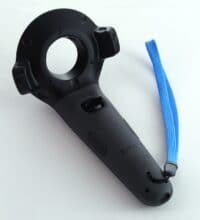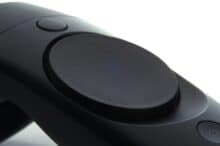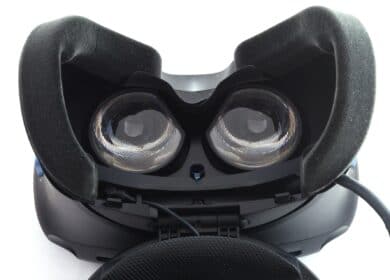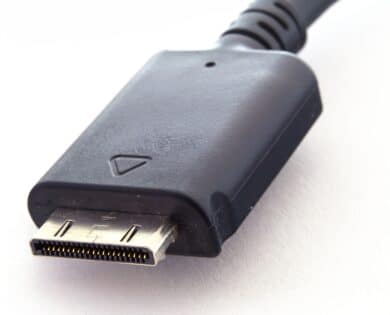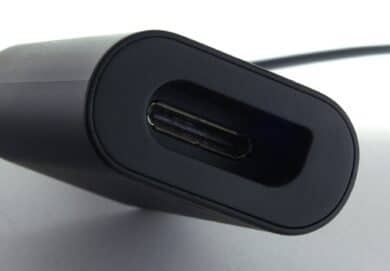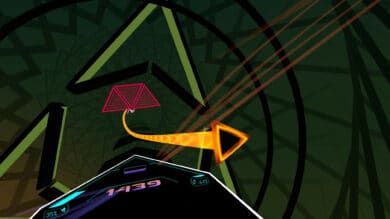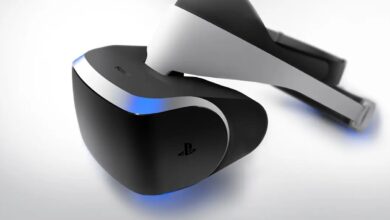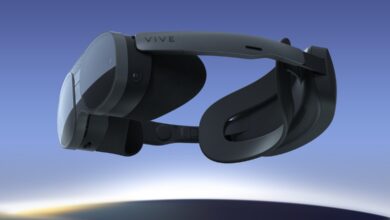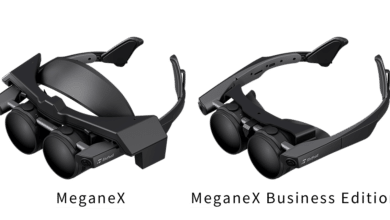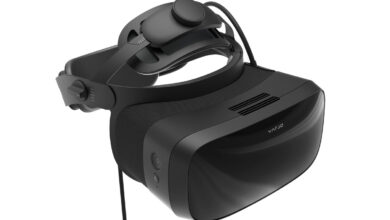
In 2016 the Oculus Rift and the HTC Vive were launched and made VR presentable. In the meantime, a lot of time has passed, numerous games and better follow-up devices were introduced. We have tried one of the latter: The HTC Vive Cosmos Elite.
Without accessories the VR headset costs 420 € (currently € 834.92 *), together with controllers and two base stations that do the tracking, the headset is available for 820 € (currently € 375.89 *).
The following article has partly the structure of a test report, but due to the lack of comparison devices it is not really supposed to be one. Instead of comparing the HTC Vive Cosmos Elite with other devices, we want to describe our first experiences with the headset and explain the advantages and problems VR brings to the current generation.
Specifications
| Resolution: | 2x 1,440 x 1,700 |
| Field of view: | up to 110 degrees |
| Repeat frequency: | 90 Hz |
| Screen type: | 3.4″ LCD |
| Sensors: | acceleration sensor, gyroscope, IPD |
| Tracking: | Lighthouse 1 |
Scope of delivery
In our case, the HTC Vive Cosmos Elite came as a complete package. Besides the headset itself, the two controllers and two Lighthouse stations were also included. If you can do without the free movement in the room, you can get along without the included accessories and only with a gamepad. But for those who want to really “dive in”, a complete set is the most sensible solution in our opinion.
If you buy the complete package, you get exactly that: HTC includes all the necessary power supplies, cables and even a wall mounting set including plugs for the base stations. Apart from a powerful computer, nothing else is needed.
The headset in detail
The HTC Vive Cosmos Elite consists of a main housing, which houses the electronics, displays and lenses, and a headband to which the speakers are attached. When the headset is put on, the face rests on foam pads while the nose is covered by two overlapping rubber covers. This almost completely covers the field of vision. Only when we looked down, we could see past the nose through a tiny gap. But this didn’t bother us during operation and instead was sometimes even useful when we were looking for something and didn’t want to take the headset off.
Directly in front of the eyes are the lenses which, in combination with the displays, enable the “VR effect”. They allow you to look at the screens, giving the brain the illusion of a much greater viewing distance than it actually has. This relaxes the eyes.
We tried the headset with different glasses and never found any problems: The picture was always sharp and the space was always sufficient. In addition, the temples of the glasses never bothered us when wearing them.
In the case of the Cosmos Elite, the headband, which distributes the weight of the glasses over the head, is made of plastic. The rear segment can be pushed continuously inwards by means of the turning screw – thus the temple is adjusted to the shape of the head. Another important feature is the elastic retaining strap on the upper side, which prevents vertical slipping.
Ergonomically, the Vive Cosmos Elite convinced us, and also haptically, everything is in the green zone: the controls are easy to reach without looking, and the quality of workmanship is good. Of course, you shouldn’t expect miracles: Features are not great with metal or anything like that, but it’s also an article of daily use to a certain extent – and that’s what we think the headset is good for.
And what about the controllers?
The controllers are still from the first generation and offer a trigger button under the index finger and a touchpad under the thumb, which can also be pressed in. As a last option there are also grip keys that register when you “squeeze” the controller with your hand.
We were able to quickly get used to these operating options in the test and also operate them blindly without any problems. The same applies to the quality of workmanship as for the VR headset: plastic, stable, well suited. With a view to the future, the use of a USB-C socket for closing time would still have been nice, but microUSB is likely to be widely used in the near future.
The equipment
After unpacking the VR headset, the first step is to set it up – at least if you are using a system with Lighthouse tracking.
Setting up the HTC Cosmos Elite takes a little time, but it is easy to master. First you have to install the driver software and the Steam app SteamVR, then well illustrated, detailed instructions will guide you through the installation. In short: The VR base stations have to be installed at two opposite corners of the gaming area, at best as high up as possible, and connected to the power supply. Mounting sets including dowels are included, but you can also proceed less invasively and simply use camera tripods. Afterwards, only the headset has to be connected and the controllers have to be switched on before the playing area is measured.
Probably the biggest difficulty in setting up is finding a free space, because SteamVR requires a free space of at least 2 by 1.5 meters – and more is better. Apart from that, the setup is unproblematic, even though we only recommend headsets with external trackers, like here, if the trackers can remain permanently set up. Alternatively, you need a headset that does the tracking via the cameras, but here there may be problems with the accuracy and field of view of the sensors.
As soon as everything is set up, all you need to do is start the game on your computer – SteamVR Home is supplied by Steam as a “base control unit”. There you can gain first experiences and start other games.
Practical experience with the headset
Our first moment in VR was overwhelming, purely subjective and without any claim to neutrality. The tracking of the head movements as well as the controllers immediately work excellently: movements are transmitted precisely and directly and you immediately feel “as if you were in it”. There is no need for a significant adjustment phase, so you can start right away.
The only thing we had to get used to was putting on the headset, because the Vive Cosmos Elite unfortunately has a rather narrow focus range. This means that if the headset is placed too far up or down, the image will quickly become blurred. To what extent this is better or worse with other VR headsets, we cannot judge due to the lack of a comparable product. But as soon as you have acquired a reliable putting on routine, even this is no longer a major problem.
Apart from that, the optics offered are more than sufficient in our eyes: An even higher resolution would be better, for example to read far away texts or to be able to marvel at the graphics even better, but for most titles the resolution is sufficient. Also typical graphic problems such as lens flares or fly screens are in our eyes within limits – in other words: they do not disturb.
We found the control by the included controller intuitive: The buttons are well positioned for all hand sizes and easy to use. Due to the action button under the index finger, the grip keys and the potentially multiple-allocated touchpad, you don’t have too many options – controlling individual fingers is not possible, for example – but it was well enough for the games we tested.
We also found the solution with the speakers praiseworthy: These can either snap into place on the ear or be attached at a certain distance. The former ensures good sound quality with high immersion – as is typical for headphones – whereas with a remaining air gap you can also hear ambient noise and talk to other people in the room. However, we found it annoying that there are really only these two click-stops. This can make it a bit difficult to engage with wide heads. The remaining degrees of freedom are in our eyes more than sufficient for all head and ear shapes.
The only thing that clouds the VR experience in our eyes in the long run is the headset’s connecting cable. At five meters long, this is long enough for all conceivable applications, but it can of course get in the way when playing games. As a result, we usually tended to shuffle rather than walk so as not to climb onto the cable. You get used to automatically avoiding the cable quite quickly, but for the last spark of immersion, a wireless transmission like the one offered for an extra charge would be better.
Another point that concerns the HTC Vive Cosmos Elite is the lack of camera functionality. Normally, they could be used to reproduce the environment in the headset so that you don’t have to take the headset off every time. However, this feature is not yet available on the headset – the corresponding field is grayed out in the configuration software. Here HTC should improve to create a little more comfort.
The game makes the experience
The hardware side of current VR headsets, or at least of the HTC Cosmos Elite, is therefore in our opinion largely successful. That leaves the software, and here there is both light and shadow. You could describe the whole thing as a kind of magnifying glass: Well implemented games are much more fun, bad implementations frustrate much faster.
Games that offer reliable control and a good portion of eye-catching features, such as Audiotrip and probably the top-selling Beatsaber, are a lot of fun and motivating, whereas other games that have a confusing movement or even performance problems quickly become exhausting. But a look at the Steam-Topseller reveals that there are more than enough representatives of the first mentioned games to keep you busy for a long time.
A worthwhile trip
If you are thinking of getting a VR headset anyway, you have probably found the perfect opportunity with the upcoming winter. If you have the necessary change for a VR headset, and a corresponding PC, you will be served a completely new kind of gaming.
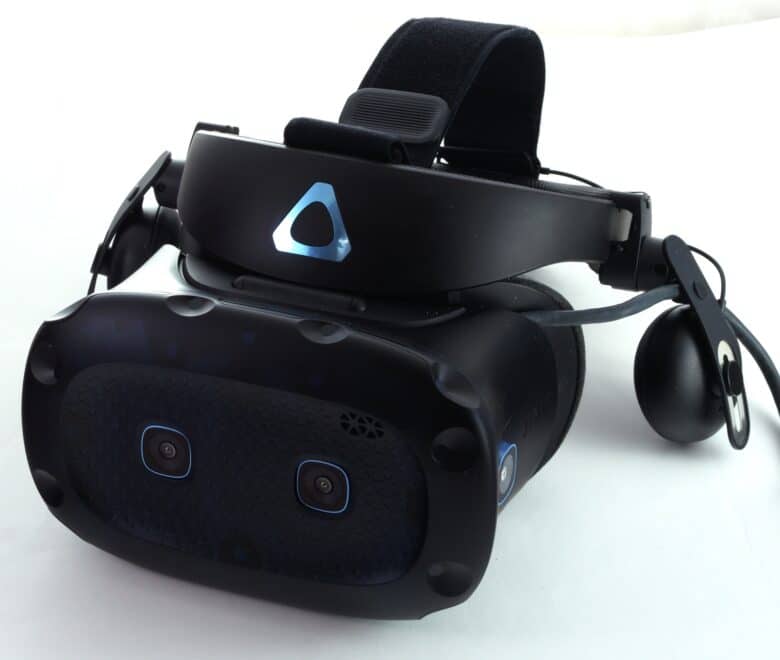
In our eyes VR is much more immersive than classic computer games, but at the same time it is also more sporty: Many of the games we try out – and especially those that we enjoyed the most – keep you on your toes and leave you feeling exhausted.
Typical VR problems with the current generation are not yet completely off the table – keyword: Motion Sickness – but this only affects some players and weakens with increasing practice. The choice of the right headset is of course still an open question, which we cannot answer here due to the lack of different devices. However, we have a very clear answer to the general question of whether the VR experience is worthwhile: Yes, and why not yesterday?

